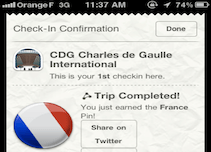 For the past 10 days, I’ve been in Paris. A few of us were there to cover the LeWeb conference, which was great, but I decided to stick around for a little while longer as I heard the city is amazing. Spoiler alert: it is. But I wasn’t on vacation, I was working. I had all my tech with me — including the best travel computer ever, the new MacBook Air, and even this thing. And, of course, my iPhone.
For the past 10 days, I’ve been in Paris. A few of us were there to cover the LeWeb conference, which was great, but I decided to stick around for a little while longer as I heard the city is amazing. Spoiler alert: it is. But I wasn’t on vacation, I was working. I had all my tech with me — including the best travel computer ever, the new MacBook Air, and even this thing. And, of course, my iPhone.
But there was something peculiar about my iPhone in Paris. It actually worked. Like it was supposed to. All the time. And it doesn’t take a genius to figure out why: there is no AT&T in Paris.
Since the initial launch of the iPhone in 2007, there have been no shortage of whispers implying that the iPhone itself is to blame for the coverage issues users are having with AT&T in the United States. There are even some compelling arguments as to why this could be at least somewhat true in certain circumstances. But all of those go out the window when you travel to a foreign country and the device just starts working as it should.
And this is hardly the first time I’ve experienced this. Back in April, I was in Japan for a little over three weeks. I was floored by how well the iPhone worked there. But I wasn’t sure that it was fair to compare it to the networks in the U.S. because I hardly saw any smartphones, let alone iPhones, anywhere in the entire country (apparently, that’s now changing).
But in Paris, the iPhone is everywhere. It seemed as if every other person I passed on the street had one. Those that didn’t, seemed to have BlackBerrys. And again, the coverage was beautiful.
The coverage was so good, in fact, that the iPhone worked on the subway in Paris. Yes, I could both place calls and surf the web while underground. Considering I haven’t been able to hold a call above ground in San Francisco for about 2 years now, this is truly amazing.
The only times I would hit dead zones in Paris seemed to be when the iPhone was switching me from one carrier to another. And it appeared to do this automatically based on signal strength. The result was a tight blanket of coverage. Again, as opposed to the blanket that AT&T provides in the Bay Area which often seems like it has more holes than cloth.
Earlier today, I arrived back in San Francisco. The first call I placed? Dropped. I then walked around my neighborhood for a bit using my favorite app: “Searching…” I was about ready to get back on the plane and go back. Well, if it didn’t cost me $1 per megabyte of data usage there (for the international rip-off, er, I mean, roaming plan compliments of yes, AT&T).
But there’s hope.
When the iPhone launched in 2007 in France it was also exclusive to one carrier: Orange. This exclusivity was eliminated in 2009 as Bouygues Telecom and SFR got to join the fun. The result was that sales of the device more than doubled. But even as the country saw this rapid expansion of the iPhone and its heavy data usage, the network didn’t cripple. Undoubtedly, because the load could be spread across all those different carriers’ spectrums. That’s what many of us are hoping will happen if and when the iPhone comes to Verizon and/or some of the other U.S. carriers early next year.
Of course, none of us will be able to hop from carrier to carrier as I was in Paris. The iPhone will undoubtedly still be locked down to whatever carrier you buy it on here. Plus, the fact that current GSM iPhones won’t work with Verizon’s current CDMA network means you will still have to choose.
Still, if AT&T is able to offload some of the iPhone weight in major metropolitan cities to Verizon (something which seems likely), there’s reason to hope the coverage will improve for the iPhone across the board.
It can work. I’ve seen it with my own two eyes and heard it with my own two ears. On a subway, no less.
